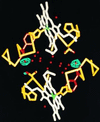Ordered water molecules as key allosteric mediators in a cooperative dimeric hemoglobin
- PMID: 8962085
- PMCID: PMC26166
- DOI: 10.1073/pnas.93.25.14526
Ordered water molecules as key allosteric mediators in a cooperative dimeric hemoglobin
Abstract
One of the most remarkable structural aspects of Scapharca dimeric hemoglobin is the disruption of a very well-ordered water cluster at the subunit interface upon ligand binding. We have explored the role of these crystallographically observed water molecules by site-directed mutagenesis and osmotic stress techniques. The isosteric mutation of Thr-72-->Val in the interface increases oxygen affinity more than 40-fold with a surprising enhancement of cooperativity. The only significant structural effect of this mutation is to destabilize two ordered water molecules in the deoxy interface. Wild-type Scapharca hemoglobin is strongly sensitive to osmotic conditions. Upon addition of glycerol, striking changes in Raman spectrum of the deoxy form are observed that indicate a transition toward the liganded form. Increased osmotic pressure, which lowers the oxygen affinity in human hemoglobin, raises the oxygen affinity of Scapharca hemoglobin regardless of whether the solute is glycerol, glucose, or sucrose. Analysis of these results provides an estimate of six water molecules lost upon oxygen binding to the dimer, in good agreement with eight predicted from crystal structures. These experiments suggest that the observed cluster of interfacial water molecules plays a crucial role in communication between subunits.
Figures




Similar articles
-
Mutational destabilization of the critical interface water cluster in Scapharca dimeric hemoglobin: structural basis for altered allosteric activity.J Mol Biol. 1998 Dec 4;284(3):729-39. doi: 10.1006/jmbi.1998.2195. J Mol Biol. 1998. PMID: 9826511
-
Mutation of residue Phe97 to Leu disrupts the central allosteric pathway in Scapharca dimeric hemoglobin.J Biol Chem. 1997 May 16;272(20):13171-9. doi: 10.1074/jbc.272.20.13171. J Biol Chem. 1997. PMID: 9148933
-
Residue F4 plays a key role in modulating oxygen affinity and cooperativity in Scapharca dimeric hemoglobin.Biochemistry. 2005 Nov 8;44(44):14419-30. doi: 10.1021/bi051052+. Biochemistry. 2005. PMID: 16262242
-
Structural and thermodynamic aspects of cooperativity in the homodimeric hemoglobin from Scapharca inaequivalvis.Biophys Chem. 2000 Aug 30;86(2-3):173-8. doi: 10.1016/s0301-4622(00)00162-9. Biophys Chem. 2000. PMID: 11026682 Review.
-
Mutagenic dissection of hemoglobin cooperativity: effects of amino acid alteration on subunit assembly of oxy and deoxy tetramers.Proteins. 1992 Nov;14(3):333-50. doi: 10.1002/prot.340140303. Proteins. 1992. PMID: 1438173 Review.
Cited by
-
Kinetic stability as a mechanism for protease longevity.Proc Natl Acad Sci U S A. 1999 Sep 28;96(20):11008-14. doi: 10.1073/pnas.96.20.11008. Proc Natl Acad Sci U S A. 1999. PMID: 10500115 Free PMC article.
-
Structural insights from water-ferredoxin interaction in mesophilic algae and halophilic archaea.Bioinformation. 2019 Feb 28;15(2):79-89. doi: 10.6026/97320630015079. eCollection 2019. Bioinformation. 2019. PMID: 31435153 Free PMC article.
-
Electron-transfer chain in respiratory complex I.Sci Rep. 2017 Jul 14;7(1):5495. doi: 10.1038/s41598-017-05779-y. Sci Rep. 2017. PMID: 28710385 Free PMC article.
-
Cooperative protein structural dynamics of homodimeric hemoglobin linked to water cluster at subunit interface revealed by time-resolved X-ray solution scattering.Struct Dyn. 2016 Apr 14;3(2):023610. doi: 10.1063/1.4947071. eCollection 2016 Mar. Struct Dyn. 2016. PMID: 27158635 Free PMC article.
-
Tertiary and quaternary allostery in tetrameric hemoglobin from Scapharca inaequivalvis.Biochemistry. 2013 Mar 26;52(12):2108-17. doi: 10.1021/bi301620x. Epub 2013 Mar 15. Biochemistry. 2013. PMID: 23458680 Free PMC article.
References
Publication types
MeSH terms
Substances
Grants and funding
LinkOut - more resources
Full Text Sources

